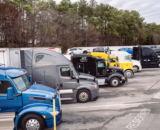The Environmental Protection Agency (EPA) on March 20, 2024, finalized its Light-Duty Vehicle Greenhouse Gas Regulations and Standards Final Rule, phasing in more stringent greenhouse gas (GHG) emissions standards for passenger cars and trucks between 2027-2032.
Under the Clean Air Act, EPA is required to establish emissions standards for criteria pollutants and greenhouse gases for light- and medium-duty vehicles.
The Final Rule contained only modest changes from EPA’s initial proposal, calling for automakers to meet an average emissions rate of 85 grams per mile compared with 192 grams current model year 2024 vehicles. EPA estimates that electric vehicle market share will increase to 55 percent of all new cars sold by 2032. Electric plug-in hybrids are projected to be 13 percent of auto sales over the same period.
NATSO said in a statement issued to media that it appreciated the Biden Administration is trying to work toward a more viable approach to reducing carbon emissions, but the Final Rule functions as a mandate for a single technology that has not yet proven itself to be more viable than other compelling solutions.
NATSO has long urged EPA to support technologies and market reforms that encourage private sector investment in all alternative fueling technologies. Rather than focus on a single technology, EPA should support all carbon reducing technologies at a level that is proportionate with their relative climate benefits and commercial viability.
Fuel Retailers Respond to Final Rule for Lowering Carbon Emissions From Light Duty Vehicles
EPA acknowledged industry comments on the proposed rule, yet the Final Rule only addressed the needs of automakers and their key manufacturing supply chains and did not sufficiently consider the need to build out a safe and reliable EV charging station network.
In its Final Rule EPA said, “Vehicle manufacturers, dealers, and representatives of the fuels industry, among others, raised concerns stating that charging infrastructure is inadequate today and that the pace of deployment is not on track to meet levels needed if the proposed standards are finalized. Manufacturers and others said customers won't buy plug-in electric vehicles if reliable charging infrastructure is not available. While they recognized the importance of the Bipartisan Infrastructure Law and the Inflation Reduction Act in supporting buildout of charging infrastructure, commenters expressed concerns that far more funding would be needed with some commenters characterizing BIL funds as a 'good downpayment'.
EPA said it agreed “with commenters that keeping up with charging needs as plug-in electric vehicle adoption grows will require continued investments in charging infrastructure."
The Agency’s final rule for heavy-duty vehicle emissions standards is expected to be released in the coming weeks.
EPA Fact Sheet on Emissions Standards for Model Year 2027 and Later
Subscribe to Updates
NATSO provides a breadth of information created to strengthen travel plazas’ ability to meet the needs of the travelling public in an age of disruption. This includes knowledge filled blog posts, articles and publications. If you would like to receive a digest of blog post and articles directly in your inbox, please provide your name, email and the frequency of the updates you want to receive the email digest.

